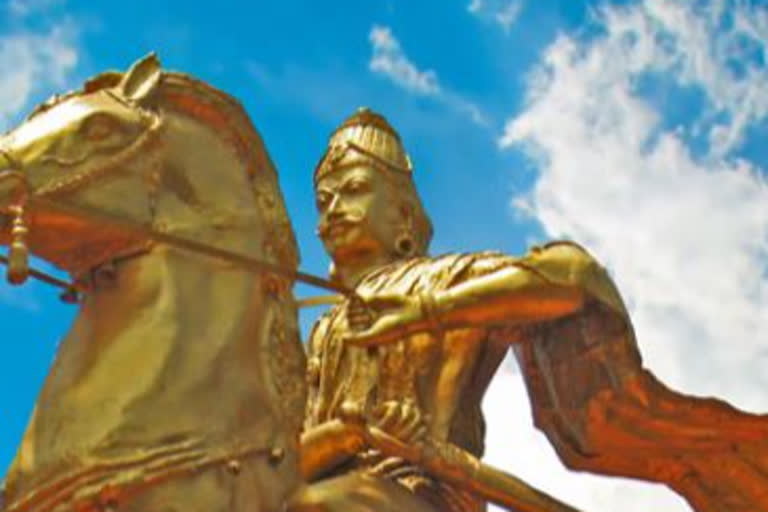Chennai: Even after a millennium, Tamils continue splitting their hairs over the caste of a great emperor, whose accomplishments as a ruler are astounding. In the resurgent caste conundrum, contributions of Raja Raja Chola to architecture, maritime trade, and commerce as well as agriculture and military prowess have been relegated to the margins. The 1037th birth anniversary, celebrated early this week on his birth star 'Sadhayam', saw the mistaken pride of many caste outfits hailing the monarch as one belonging to them.
Besides a few dominant OBC and intermediary communities, a couple of Dalit communities have joined the chorus of laying claim to him. And this year it was more pronounced due to the impact of Mani Ratnam's movie, 'Ponniyin Selvan' (PS - 1) based on Kalki R Krishnamurthy's celebrated five-part novel of the same name, reviving interest in the past. The DMK government of MK Stalin too decided to bask in the Chola glory by holding the 'Sadaya Vizha' as a government event from this year onward. Earlier, the government had announced a Chola tourism circuit.
While the movie was a massive hit at the box office, it had an unintended fallout over the religious identity of Raja Raja with national award-winning director Vetrimaaran stirring up a hornet's nest by alleging that there was an attempt to saffronize the emperor and other Tamil icons. Even versatile actor and Makkal Needhi Maiam party president Kamal Hassan waded into the controversy by saying that in those times, there was no Hinduism. BJP and the Sangh Parivar crossed swords with Dravidian ideologues and pro-Tamil leaders, who hold the empire builder as a pride of the Tamils. Sadly, the debate was restricted to who could own up to the past and not on the various dimensions of the reign of the latter Cholas.
Initially, there was confusion on the birthday of Raja Raja with both KA Neelakanta Sastri and Sadasiva Pandarathaar fixing it on the star Thiruvaathirai in the Tamil month of Margazhi (Mid December-Mid January). This was based on an inscription at Tiruvottiyur by the emperor's son Rajendra Chola. But, a later inscription found at Thiruvarur, also of Rajendra, clearly mentioned the birth of his father as Sadhayam in the Tamil month of Aippasi (Early November).
Also Read: TN govt to upgrade urban roads at a cost of Rs 2,200 cr
To his credit, he had won many battles and brought under his empire, Sri Lanka, Odisha, Andhra Pradesh, and parts of Maharashtra. With a powerful navy, during the reign of his son, the Bay of Bengal turned into a Chola lake. Raja Raja built the Brihadeeswarar temple, a marvel in granite now a UNESCO heritage monument. In fact, he had named it as 'Peru Udaiyaar Kovil' and 'Raja Rajeswaram'.
Expansion of agriculture with the creation of lakes and water courses also saw lands surveyed and tax regularised. Local bodies were given a free hand with elections to the village assemblies. However, historians have maintained that it was during the Cholas that caste segregation got entrenched and Tax-free Brahmin settlements were set up. But, he is hailed for taking on the Dikshithars of the Chidambaram Nataraja temple and retrieving the Saivaite compendium of hymns besides popularising 'Thevaram' (sacred hymns of the four preeminent Saivite saints) recital in temples.
But, strangely enough, his caste identity, of which no one is sure, has become a bone of contention even as the Sangh Parivar wants to see him through a religious prism and the Tamil apologists hold him as the pride of Tamils. The following OBC communities: Nadar, Vanniyar, Kallar, Udaiyar, Naidu, Yadav, Mutharaiyar, and Maravar besides the Dalit communities: Devendra Kula Vellalar and Paraiyar have all been reclaiming a past as theirs.
What does this signify? “It is the exuberance of the present and an appropriation of history to establish caste hegemony and legitimacy with an eye for contemporary gain. Caste structure and texture during the Cholas were different as it has undergone a metamorphosis over the period and during the colonial era. Yet, for such an attempt, history is used as a tool to establish authority and caste, the agent,” explains R Thirunavukkarasu, teaching Sociology at the University of Hyderabad. “It is highly regressive,” he added.
But, for the right wing, there is no harm in this. “Every caste claiming him to be their man is perfectly justified. There is nothing wrong with it. Unlike in the north, we in the south did not have a clear, codified, and stratified caste hierarchy during the time of Raja Raja. So, it is only natural for every caste to lay claim. They are all his descendants,” argues Raveendran Duraisamy, a commentator with saffron leanings. Asked whether this does not run counter to the claim of the monarch being a Hindu, his response was, “No, never. For, Hindu consciousness is coupled with Caste consciousness. So from the OBC Vanniyars and including the Devendra Kula Vellalar (an SC community), can identify with him.”
Well, the lure of the past remains undiminished if it serves a purpose, and politics is no exception.



